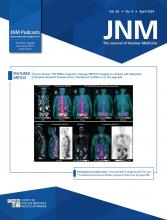Abstract
Previous studies have suggested that early changes in blood flow (BF) in response to neoadjuvant chemotherapy and evaluated with 15O-water are a surrogate biomarker of outcome in women with breast cancer. This study investigates, in the triple-negative breast cancer (TNBC) subtype, the prognostic relevance of tumor BF changes in response to chemotherapy, assessed using a short dynamic 18F-FDG PET acquisition. Methods: Forty-six consecutive women with TNBC and an indication for neoadjuvant chemotherapy were prospectively included. Women benefited from a baseline 18F-FDG PET exam with a 2-min chest-centered dynamic acquisition, started at the time of 18F-FDG injection. Breast tumor perfusion was calculated from this short dynamic image using a first-pass model. This dynamic PET acquisition was repeated after the first cycle of chemotherapy to measure early changes in tumor BF (ΔBF). Delayed static PET acquisitions were also performed (90 min after 18F-FDG injection) to measure changes in tumor glucose metabolism (ΔSUVmax). The association between tumor BF, clinico-pathological characteristics and patients’ overall survival (OS) was evaluated. Results: Median baseline tumor BF was 21 ml/min/100g [range, 6-46 ml/min/100g] and did not significantly differ according to tumor size, SBR grade or Ki-67 expression. Median tumor ∆BF was -30% with highly scattered values [range, -93%;+118%]. A weak correlation was observed between ΔBF and ∆SUVmax (r=+0.40, P = 0.01). The median follow-up was 30 months (range, 6-73 months). Eight women developed recurrent disease, seven of whom died. Low overall survival was associated with menopausal history (P = 0.03), persistent or increased tumor vascularization on the interim PET (ΔBF cut-off = -30%; P = 0.03), non-breast-conserving surgery (P = 0.04) and the absence of a pathological complete response (pCR) (P = 0.01). ΔBF and pCR provided incremental prognostic stratification: 3-years OS was 100% in pCR-women; 87% in no-pCR women but achieving an early tumor BF response; and only 48% in no-pCR/no-BF response women (ΔBF cut-off=-30%, p<0.001). Conclusion: This study suggests the clinical usefulness of an early “user- and patient-friendly” 2-min dynamic acquisition to monitor breast tumor blood flow changes to neoadjuvant chemotherapy using 18F-FDG PET/CT. Monitoring tumor perfusion and angiogenesis response to treatment seems to be a promising target for PET tracers.
- Copyright © 2016 by the Society of Nuclear Medicine and Molecular Imaging, Inc.







